Tick vs. Bed Bugs: Differences and Similarities
Are you concerned about pests, like ticks and bed bugs, invading your home? Understanding the differences between two common blood-sucking pests, ticks and bed bugs, is important. We want to make sure you know exactly what kind of pests you’re dealing with, so we’re going to take a close look at the physical characteristics, habitat, and behavior of both ticks and bed bugs. This will help you determine what kind of pest control methods you can use to remove the type of pests you have.
We’ll also talk about any diseases they might be able to pass on to humans or pets, and we will give you some tips on how to get rid of them if you have an infestation. We will also answer some of the most common questions people have about these pests, like what bed bug bites look like and whether lice and bed bugs are the same thing.
What are Bed Bugs?
Bed bugs are small flat, about the size of an apple seed, pests that feed on human blood. They live in furniture such as beds or couches where they can easily hide during the daytime when people are not around. These posts usually come out at night when people sleep so that they can feed off their hosts without being detected. They have a reddish brown color with oval-shaped bodies measuring up to 5mm long, slightly larger than an apple seed.
They are commonly found worldwide these days due to increased travel habits from one place to another. Moreover, bed bugs often spread through luggage items such as suitcases or clothing items carried by travelers from one hotel room and home into another.
You would not know you already have bed bugs in your items, not unless you see and experience signs and symptoms below.
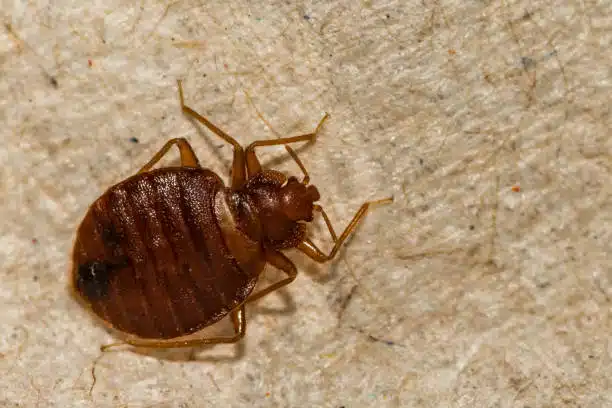
- Sweet, musty odor: Bed bugs emit a distinct odor that is often described as sweet and musty. This odor is caused by the pheromones’ bed bugs release, which can help them communicate with one another and locate mates. The odor can become stronger as the infestation grows.
- Specks of blood: Small spots of blood on sheets, mattresses, and other surfaces. Are left by bed bugs after they suck their host’s blood. These spots of blood are often tiny and are reddish-brown.
- Shells: As bed bugs grow and mature, they molt or shed their shells or exoskeletons, leaving behind empty casings. These casings are often translucent and may be found near areas where bed bugs are hiding or feeding. The exoskeletons of bed bugs may also indicate the age of the bed bugs.
- Tiny, blackish specks: Bed bugs also leave small droppings or fecal matter that can appear as tiny, blackish specks. These specks may be found on sheets, mattresses, and other surfaces near areas where bed bugs are hiding or feeding. This sign can also indicate the location where bed bugs usually hide.
- Eggs: Female bed bugs lay eggs that are often found in clusters or groups. The eggs are tiny, usually less than 1mm in size, and are white or translucent in color. They may be found in crevices, cracks, and other hiding places where bed bugs are likely to be found.
What are Ticks?
Ticks belong to the arachnid family, just like spiders. But unlike spiders, ticks need a blood meal for survival. Hence, tick bites hurt because its proboscis pierces through skin tissue in order to draw blood away from the host body successfully. Thus, effectively sustains itself after its feeding has been completed, thereby allowing it to move on to the next victim.
Ticks are commonly found outside in grass, trees, shrubs, and leaf piles. That’s why ticks usually bite pets because they spend ample time outdoors. But ticks can also bite humans. They will bite in the armpits, groin, hair, back of the knees, inside the belly button, around the waist, and inside and around ears. To know if there are ticks in your home, see the symptoms below for both humans and pets.
For humans
- Skin rash: A rash around the bite site is a common symptom of tick bites. The rash may appear as a red, circular patch or a bull’s eye pattern.
- Flu: Lyme disease, Rocky Mountain spotted fever, and Babesiosis can cause flu-like symptoms, including fever, headache, muscle aches, and fatigue.
- Joint pain: Some tick-borne illnesses can cause joint pain, swelling, and stiffness.
- Neurological: In severe cases, tick-borne illnesses can cause confusion, seizures, and paralysis.
- Allergic reactions: Some people may experience itching, swelling, and difficulty breathing.
For pets
- Visible ticks on the pet’s skin, particularly around the ears, neck, and head.
- Redness or inflammation around the tick bite area.
- Itching or scratching at the tick bite site or other areas of the body.
- Fever or lethargy.
- Loss of appetite or weight loss.
- Joint pain or stiffness.
- Swollen lymph nodes.
- Pale gums
Differences between ticks and bed bugs
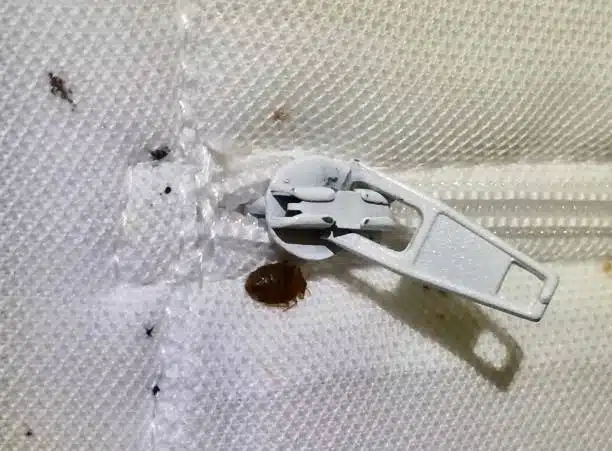
Now, we know that both ticks and bed bugs bite. The question is, are lice and bed bugs the same? Apparently, no, they are not. Below are the differences between the two pests.
- Appearance: Bed bugs are typically larger than ticks. Bed bug size can range from 6mm to 8mm. On the other hand, the tick’s size will only reach about 4mm. Moreover, bed bugs only have 6 legs, while ticks have 8. Their colors differ as well. Bed bugs are reddish brown, while ticks are dark brown.
- Behavior: Ticks are most likely to bite animals because they are more exposed to them. They are typically found in wooded or grassy areas, where pets usually explore. Then, ticks will attach themselves to their host to feed. Bed bugs are also parasitic and feed on the blood of humans and animals, but they mostly bite humans because they are usually the ones indoors. Bed bugs usually hide on the crevices and gaps around the bed where humans usually sleep.
- Health risks: Bed bugs do not carry or spread diseases. But ticks do. Ticks are known to transmit Lyme disease, and Rocky Mountain spotted fever, and other diseases. Bed bugs are not known to transmit diseases, but their bites can cause allergic reactions and secondary infections.
- Detection: Ticks are easier to detect than bed bugs because they are larger and visible to the naked eye. Bed bugs are smaller and harder to see, and their bites may be mistaken for other skin conditions.
Treatment for Ticks and Bed Bugs
The reason why you should know the difference between ticks and bed bugs is their treatments are not the same as well. Tick bites require careful removal of the tick and may require medical attention if a tick-borne illness is suspected. Bed bug bites can be treated with antihistamines and corticosteroid creams to relieve itching and swelling.
However, for future reference, it is best to call experts in tick and bed bug removal. Bed bug removal usually involves a combination of methods, such as vacuuming, steam cleaning, and the use of pesticides and bed bug traps. The goal is to eliminate bed bugs from all infected areas, including bedding, furniture, and other areas where bed bugs may be hiding. Otherwise, bed bugs will just keep on jumping from one place to another. Bed bug removal can be time-consuming, requiring careful inspection and treatment of multiple areas in a home or building.
On the other hand, tick removal involves carefully removing the tick from the skin to prevent further infection. Ticks should be removed using tweezers to get a hold of the tick’s mouth. This will help you get as close to the skin as possible to prevent the head from staying inside the skin. After removal, the area should be cleaned and disinfected.
Related Articles
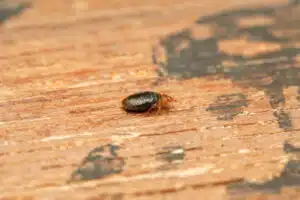
Tick vs. Bed Bugs: Differences and Similarities
Understanding the differences between two common blood-sucking pests, ticks and bed bugs, is important. We want to make sure you know exactly what kind of pests you’re dealing with,
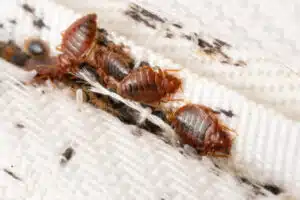
Where Do Bed Bugs Come From, and How to Prevent Them? A Guide for Salt Lake Residents
Bed bugs can be a major nuisance and cause various physical and emotional problems, including skin irritation, anxiety, and sleep disturbances. In Salt Lake City, bed bugs are a growing concern, especially in apartment buildings, hotels, and other high-density living spaces. But where do bed bugs come from, and how can you prevent them from infesting your home or property?
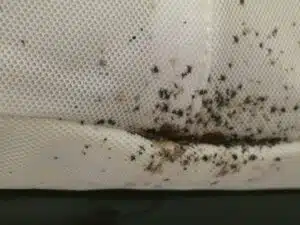
Are All the Tiny Black Bugs in My Bed Bed Bugs?
Sleeping is one of the things that we look forward to after a very long day. We recharge ourselves by sleeping by the end of the night to be refreshed the next day. But we can be disturbed even during our sleep by pesky pests crawling and hiding where we sleep. That’s terrifying, right? Pests that are known to annoy us during our sleep are bed bugs. They are usually found where humans and other pets sleep. Bed bugs can be almost anywhere in the world – even in your Saltlake home! They can be annoying because they suck your blood and leave you with an itch and bumps in the infected area. So blood attracts them, even the blood of other animals. Therefore, you should conduct bed bug removal if you have them. If you find bugs on your beds, you might think they are bed bugs. But are they?

Can Bed Bugs Live in Your Car?
Bed bugs are small, flat, and oval-shaped insects that feed on the blood of humans and animals. During the day, bed bugs hide in cracks and crevices around beds, furniture, and baseboards. You can also find them in mattresses, bed frames, blankets, carpets, and other fabric items throughout your home. While it is possible for bed bugs to infest your car, they’re less likely to do so than inside a house or other structure.
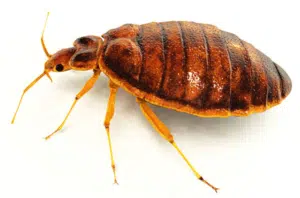
How to Find Bed Bugs in Your Home
Bed bugs are small, blood-sucking that feed on human and animal blood. They belong to the family Cimicidae, contain over 100 species, and have been around for millions of years.

Can Bed Bugs Jump?
Bed bugs are a common household pest that can be difficult to get rid of. These tiny insects can live in any crevice or crack in your home and feed on blood.
